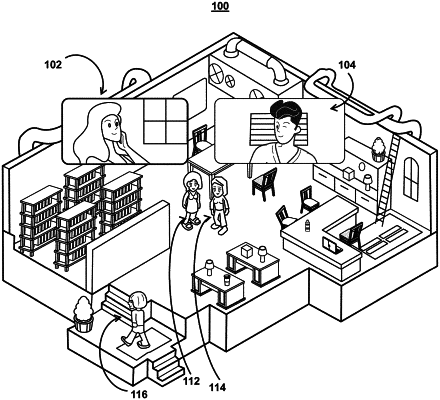| CPC H04N 7/157 (2013.01) [G06F 3/0484 (2013.01); G06T 11/00 (2013.01); G06T 13/80 (2013.01); H04L 12/1822 (2013.01); H04L 65/1069 (2013.01); H04L 65/403 (2013.01); H04N 7/152 (2013.01)] | 18 Claims |

|
1. A system for triggering livestream communications between users based on proximity-based criteria for avatars within virtual environments that correspond to the users, the system comprising:
a first computer terminal comprising a first user interface and a first webcam;
a second computer terminal comprising a second user interface and a second webcam;
a third computer terminal comprising a third user interface and a third webcam;
a server configured to:
generate for simultaneous display a first virtual environment on a plurality of user interfaces, wherein a respective user interface of the plurality of user interfaces is accessible to each of a first user, a second user, and a third user, wherein the first user, the second user, and the third user are located remotely from each other;
generate for display, in the first virtual environment, a first avatar corresponding to the first user, a second avatar corresponding to the second user, and a third avatar corresponding to the third user, wherein the first avatar comprises a virtual representation of the first user that may be navigated about the first virtual environment, wherein the second avatar comprises a virtual representation of the second user that may be navigated about the first virtual environment, and wherein the third avatar comprises a virtual representation of the third user that may be navigated about the first virtual environment;
generate for display on the respective user interfaces for the first user and the second user a conversation, wherein the conversation comprises a livestream communication using the first webcam and the second webcam;
determine, for the third avatar, a third position in the first virtual environment;
determine, for the conversation, a conversation position in the first virtual environment;
determine one or more join areas based on the third position or the conversation position, wherein the conversation position is based on a first position for the first avatar and a second position for the second avatar, and wherein determining the one or more join areas based on the third position or the conversation position comprises determining a third join area about the third position and a conversation join area about the conversation position;
compare the one or more join areas to one or more conversation initiation criteria to determine whether to allow the third user to join the conversation, wherein comparing the one or more join areas to the one or more conversation initiation criteria to determine whether to allow the third user to join the conversation further comprises:
retrieving a threshold overlap area for allowing the third user to join the conversation;
determining an overlap area between the third join area and the conversation join area; and
determining whether the overlap area equals or exceeds the threshold overlap area; and
in response to determining to allow the third user to join the conversation, add the third user to the conversation using the third webcam, wherein adding the third user to the conversation comprises generating for display, the livestream communication, on the respective user interfaces using the first webcam, the second webcam, and the third webcam.
|